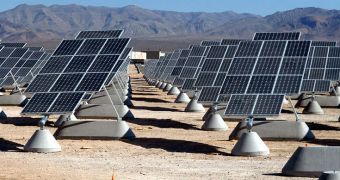Scientists at the Arizona State University (ASU) have recently taken an innovative step towards boosting the efficiency of photovoltaic solar cells. They say that adding graphite nanoparticles to the devices allows them to produce more electricity from the same amount of sunlight.
This is only the latest in a string of advancements that is contributing to reducing the costs associated with building solar power planets. The new technologies are also helping to make this industry more profitable, and more attractive to investors.
In the end, incremental improvements might be all it takes to put alternative energy in general on the map, and to finally rid the world of burning fossil fuels such as coal, natural gas and oil.
At this point, one of the most severe problems plaguing photovoltaic (PV) cell technologies is the fact that solar panels cannot convert but a small portion of the sunlight that is hitting them every second.
This limitation leads to the rest of the light beams transforming into heat, which is wasted energy as far as turning it into electricity goes. What's worst is that the excess heat is preventing the normal operation of the panels even further, Science Blog reports.
According to ASU graduate student in mechanical engineering Robert Taylor, the heat that results from solar power plants could itself be harnessed for electricity production. This can be done via solar thermal collectors, which come in many shapes and sizes.
What they do is collect excess heat, which then goes on to boil water, generating Steam that drives a turbine. The basic operating principle is the same as the one used in BWR nuclear reactors, where fission is used instead of sunlight to heat water, and generate steam.
But Taylor says that there are other ways of boosting PV cells' efficiency as well. One of them is to add graphite nanoparticles into heat-transfer oils that are used in solar thermal power plants.
By adding this carbon compound alone, the efficiency of the entire system could increase by no less than 10 percent. Part of this effect is caused by the fact that graphite is black, and therefore absorbs light very efficiently.
“We estimate that this could mean up to $3.5 million dollars per year more revenue for a 100 megawatt solar power plant,” the ASU graduate student adds, quoted by Science Blog. He adds that nanoparticles come cheap too, at just $1 per gram.
But 100 grams of graphite nanoparticles provide the heat-collecting surface of an entire football field, Taylor explains. In addition to graphite, the new system could also use soot particles, of the kind fossil fuel-powered electrical plants produce by the millions of tons.
“It might also be possible to filter out nanoparticles of soot, which have similar absorbing potential, from coal power plants for use in solar systems. I think that idea is particularly attractive: using a pollutant to harvest clean, green solar energy,” Taylor concludes.

 14 DAY TRIAL //
14 DAY TRIAL //